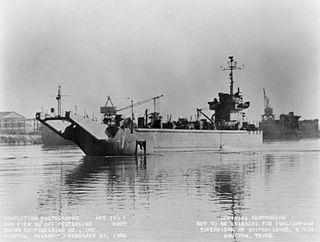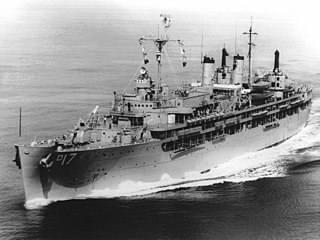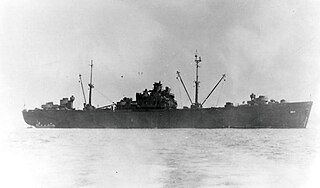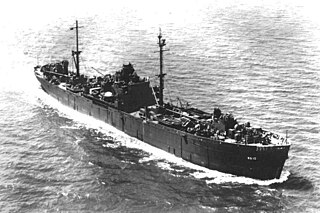
USS Hopewell (DD-681) was a Fletcher-class destroyer in service the United States Navy from 1943 to 1947 and from 1951 to 1970. She was finally sunk as a target in 1972.

USS Luzerne County (LST-902) was an LST-542-class tank landing ship built for the United States Navy during World War II. Named after Luzerne County, Pennsylvania, she was the only U.S. Naval vessel to bear the name.

USS Leyte (ARG-8), later USS Maui (ARG-8), was a Luzon-class internal combustion engine repair ship that saw service in the United States Navy from 1944 to 1946. She was scrapped in 1972.

USS Culebra Island (ARG-7) was a Luzon-class internal combustion engine repair ship in the service of the United States Navy from 1944 to 1947. She was scrapped in 1974.

USS Cebu (ARG-6) was a Luzon-class internal combustion engine repair ship that saw service in the United States Navy during World War II. Named after Cebu, an island in the Philippines, it was the second ship of the Navy to bear this name.

USS Holland (AS-3) was a submarine tender that served in the United States Navy before and during World War II. Holland was launched by the Puget Sound Naval Shipyard, Bremerton, Washington on 12 April 1926, sponsored by Miss Elizabeth Saunders Chase, daughter of Admiral J. V. Chase, and commissioned on 1 June. Stationed at San Diego, California, tending submarine divisions there with periodic tours to Panama to service submarines based at the Canal Zone pre-World War two. Later serving in the Pacific theatre, by close of hostilities having given 55 instances of refit to submarines, provided repair and service to 20 surface craft and completed various jobs on shore installations.

USS Kermit Roosevelt (ARG-16) was a Luzon-class internal combustion engine repair ship that saw service in the United States Navy during World War II. She was the only U.S. Naval vessel to be named for Kermit Roosevelt I, the second son of President Theodore Roosevelt and a soldier who served in two world wars.

USS Gypsy was the lead ship of her class of salvage lifting vessels serving in the United States Navy. Originally designated LSM-549, she was launched by Brown Shipbuilding Corporation, Houston, Texas, on 7 December 1945, and commissioned on 18 March 1946 at Houston.

USS Piedmont (AD–17) was a Dixie-class destroyer tender built during World War II for the United States Navy. Her task was to service destroyers in, or near, battle areas and to keep them fit for duty. She served in the Pacific Ocean during World War II, the Cold War, the Korean War, and the Vietnam War. For her work in battle areas, the ship was awarded four battle stars for her Korean War efforts and one for Vietnam War service.

USS Mindanao (ARG-3) was a Luzon-class internal combustion engine repair ship in service with the United States Navy from 1943 to 1947. She was sunk as an artificial reef in 1980.

USS Luzon (ARG-2) was an internal combustion engine repair ship in service with the United States Navy from 1943 to 1947 and from 1950 to 1960. She was the lead ship in a class of twelve ships and was scrapped in 1974.
USS Romulus (ARL-22) was laid down as a United States Navy LST-542-class tank landing ship but converted to one of 39 Achelous-class repair ships that were used for repairing landing craft during World War II. Named for Romulus, she was the only US Naval vessel to bear the name.

USS Oahu (ARG-5) was a Luzon-class internal combustion engine repair ship that saw service in the United States Navy during World War II. Named for the Island of Oahu, third largest island in the Hawaiian chain, it was the second US Naval vessel to bear the name.

USS Mona Island (ARG-9) was Luzon-class internal combustion engine repair ship in service with the United States Navy from 1944 to 1947. She was sunk as an artificial reef in 1975.

USS Jennings County (LST-846) was an LST-542-class tank landing ship built for the United States Navy during World War II. Named after Jennings County, Indiana, she was the only U.S. Naval vessel to bear the name.

USS Laertes (AR-20) was a Xanthus class repair ship in the service of the United States Navy from 1945 to 1972.

USS Tutuila (ARG-4) was a Luzon-class internal combustion engine repair ship that saw service in the United States Navy during World War II, The Korean War, and The Vietnam War as well as several smaller actions. Named for the Island of Tutuila, the largest and main island of American Samoa, it was the second US Naval vessel to bear the name. After serving for nearly 30 years Tutuila was sold to the Republic of China in 1972.

USS Samar (ARG-11) was a Luzon class internal combustion engine repair ship that saw service in the United States Navy during the final days of World War II, and in the post-war period. Named for the Samar Island in the Philippines, it was the second U.S. Naval vessel to bear the name.

USS Palawan (ARG-10) was a Luzon class internal combustion engine repair ship that saw service in the United States Navy from 1945 to 1947. She was sunk as an artificial reef in 1977.

USS Chourre (ARV-1) was a Chourre-class aircraft repair ship that saw service in the United States Navy during World War II and the Korean War.



















